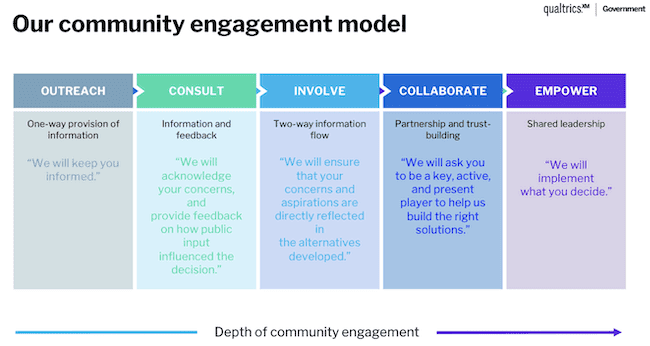Intro
Across state and local government, community engagement strategies are changing to meet resident expectations. But the most successful agencies aren’t just collecting more feedback, they’re fundamentally transforming how they deliver services based on what they hear. Here’s how taking a fresh look at your community engagement initiatives can help you better serve your constituents in 2026 and beyond…
What is community engagement?
Community engagement is the ongoing process of the government seeking to listen to, understand, and act on residents’ values, concerns, and aspirations.
The most successful community engagement strategies ensure that the ideas and opinions of community members are prioritized – and utilized – to help drive governmental services and systems development.
Community engagement can take many forms and research methods, from in-person meetings or workshops to always-on digital open doors and surveys. Community engagement helps governments build community-centric programs, plans, and policy – sometimes in collaboration with community members themselves.
The evolution of community engagement strategies
Today, community engagement is changing. While traditional approaches – like town halls and focus groups – are still great ways to solicit structured, direct feedback and sentiment, governments will only ever form an incomplete picture without listening across the breadth of other touchpoints available to them.
The problem isn’t that traditional engagement methods are wrong, it’s that they’re incomplete without listening across all the ways residents interact with government services.
That means today’s government leaders must think more broadly to capture every possible signal. This is a shift predicated on the solicitation of input that spans digital and offline channels, including:
- Online communities
- Social media platforms
- Community public comment activities
- Contact center data
Bringing these touchpoints together – and acting on what arises – is how governments can foster support from local community stakeholders and, ultimately, leave residents feeling heard and empowered.
This can be best described as a shift from community engagement strategies to community experience ones – a broader process of understanding, acting on, and improving on expectations.
Free eBook: Omnichannel CX for state and local government
Why is a community engagement strategy important?
Government should be a two-way street – it’s about issuing policies that are informed and supported by residents. That in itself makes community engagement really important; it’s a practice that acts as ongoing, continual pulse checks.
Community members judge their state and local governments on every interaction they have with them: permits, payments, service requests, phone calls, social media posts – and everything in-between. Trust is built transaction by transaction. So it pays to involve people in regular conversation, understand what they think, and learn from their input.
More importantly, residents expect to see action from their feedback. When governments collect input, but fail to demonstrate how it influenced actual service improvements, they create an experience gap that erodes public trust and wastes taxpayer resources.
Conversely, the consequences of not deploying effective community engagement strategies are costly. It can help avoid reworking projects the public is unhappy with or launching services that are not relevant to a community.
Without regularly engaging local communities to understand their experiences, government organizations deepen the divide between government and community which fosters distrust. Additionally, this lack of strategy leaves historically underrepresented communities further segregated from conversations that directly involve and impact them.

Modern community engagement strategies: Moving beyond listening
It’s important to remember that true community engagement means moving beyond simply gathering feedback. Building a bank of opinions but failing to act on them creates an experience gap for residents who’ll feel unheard.
Many platforms focus solely on listening – monitoring social media, collecting survey responses, or aggregating feedback. But collection without connection to actual service delivery improvements leaves governments with data they can’t act on and residents who feel ignored.
Modern community engagement, then, is all about using the right tools to turn insight into action. That means combining feedback from traditionally disparate places into a single source of truth – and using cutting-edge technology like AI to surface trends and patterns that shine a light on areas for improvement. Most importantly, it means integrating these insights directly with existing government systems–from permit processes to payment platforms–so feedback immediately informs service delivery transformation.
All of which leads us nicely on to…
Building a successful community engagement strategy
1. Get to know the community engagement spectrum
The best community engagement strategies are ones built on an understanding of engagement depth – and working to move further along the stages of the following five-step model:
- Outreach: Provide the public with balanced and objective information.
- Consultation: Obtain feedback analysis, alternatives, and decision
- Involvement: Work with community members to ensure that concerns are consistently understood and considered.
- Collaboration: Partner with community members to identify the preferred solution and develop alternatives
- Empower: Engage community members in the final decision-making process

*This framework is influenced by the International Association for Public Participation, augmented by our subject matter experts.
In an ideal world, government agencies should look to move their community engagement efforts further and further along this spectrum.
That’s because, when governments empower residents, they literally flip the script on traditional community engagement – where instead of making a decision behind the proverbial closed doors, governments turn decision-making over to the public.
Participatory budgeting is a great example of an empowered community engagement effort that has been gaining momentum in recent years. In participatory budgeting, governments work with a group of community partners to shape the budgeting program and then host a voting period where community members decide how to allocate a pool of funds.
Like collaborative community engagement efforts, empowerment efforts also rely on high levels of civic engagement. But as governments start to recognize the transformative power of designing plans, programs, and policies with – not for – communities, leaders are finding more ways to share power and encourage community participation.
With modern community engagement tools, leaders can host decision-making processes digitally, as opposed to relying on in-person deliberation. Multiple engagement channels – mobile, phone, in-person, online, etc. – allow leaders to expand community engagement efforts and reach more people. They might start an empowerment engagement by first soliciting community ideas through a widespread ask and then asking community members to vote on their preferred options.
2. Mix old and new community engagement methods
Community engagement strategies need to combine longstanding, traditional approaches with emerging, data-driven tools and practices.
Tried and tested methods for capturing feedback and opinion still play a really important role in building trust and connection with community members, but modern tools make it easier to capture (and combine) insights – and act on them in real time. Mixing these approaches means governments can reach community members where they are, and ensure engagement is both inclusive and continuous.
Traditional community engagement strategies include:
- Town halls and community meetings that create space for open dialogue and accountability
- Public consultations and surveys can gather structured feedback from a broad cross-section of residents
- Advisory groups and committees foster ongoing collaboration and representation
Modern community engagement methods focus on:
- Optimizing service delivery touchpoints using everyday transactions as opportunities to listen and engage
- Multi-channel/omnichannel service strategies that combine digital platforms, mobile apps and in-person channels to reach diverse audiences
- Real-time feedback loops, like digital prompts or follow-up surveys at the point of service, that quickly identify issues and help demonstrate responsiveness
3. Integrate feedback into service delivery
An effective community engagement strategy shouldn’t sit apart from core service delivery – it should be built right into it. Integrating feedback and engagement into everyday operations ensures that co-design becomes part of how services are planned and delivered, instead of being an afterthought. This thinking can help agencies…
- Make participation routine
- Capture insights at the point of service
- Continuously improve outcomes based on real input
- Transform service delivery based on actionable insights, not just data collection
An important step here is to map various kinds of community engagement to relevant service touchpoints. Mapping things out is a process that’ll help identify where and how people naturally connect with each service, and where additional engagement could add value.
For instance, if people are more likely to offer feedback on their tax process on an owned website channel, on a social media platform, or over the phone? Are opinions on new construction projects coming in via email, or via surveys?
This exercise will also highlight where your listening and acting processes need a tune up. Understanding critical moments for listening, consultation, and collaboration ensures that engagement activities align with community members’ real-world journeys. It helps identify opportunities to connect feedback directly to service improvements that residents will experience.
4. Adopt a more transactional ‘customer journey’ approach
Thinking like in terms of transactions doesn’t mean being cutthroat – it means adopting modern approaches to customer experience management that today’s businesses use to deliver memorable service.
By breaking down the journey into distinct transactions – like applying for a permit or accessing support – government teams can work towards understanding the motivations, pain points, and expectations that shape public interaction. This approach supports more targeted, meaningful engagement that feels relevant to each step of the process.
This approach also means thinking of your residents as stakeholders. At the heart of any community engagement strategy is a deep understanding of the people it serves, which makes residents more than just recipients of services – it means they’re active participants with lived experience and insights.
Taking the time to understand different community groups – including their priorities, barriers to participation, and preferred ways of engaging – will help government teams design engagement activities that are inclusive, accessible, and relevant.
Community engagement strategies: Best practices

1. Lead with inclusivity
Don’t wait for results to think about inclusion; design community engagement strategies that proactively reach all community groups by default. Community engagement tools that offer multi-channel distributions, like phone, digital, in-person, mobile, etc. will help you meet your residents where they are.
2. Listen to the experts at scale
Leverage technology to engage your community at scale, prioritizing tools with modern user interfaces that are designed to make it as easy as possible for people to participate. Some tools will even analyze your questions and provide specific tips for how to increase engagement.
3. Start a conversation, not a one-off project
Community members experience the impacts of programs and policies every day, so it’s wise to shift your engagement efforts from one-off projects to ongoing conversations. Look for tools that allow you to continuously collect community experience data and analyze it for you – forming a digital ‘open door’ that allows residents to provide community feedback in their own words when it’s most relevant to them.
What does success look like? A modern community engagement strategy example
Faced with the challenges of revitalizing the city’s downtown area, redesigning the city’s branding and reinvigorating work processes, the City of Corona’s IT department saw an opportunity to use technology to bring resident and employee voices to the table.
Corona employed Qualtrics® AI capabilities to first understand what residents were saying about the city on social media platforms. Then the city’s IT team developed omnichannel programs to reach populations that were underrepresented in decision-making, with opportunities for residents to submit feedback via social media, the website, digital surveys, texting and location-based QR codes at events and concerts.
They integrated resident input with GIS location points to analyze variations in experiences and ensure representation across the city. That resulted in:
- 10x increase in resident engagement
- 2400 insights for downtown revitalization
- 28% increase in employee satisfaction
This approach demonstrates how modern community engagement goes beyond listening platforms to create actual transformation that benefits both residents and government efficiency.
How Qualtrics can help
For any governments looking to strengthen their community engagement activities, the right tools can make a world of difference.
Qualtrics provides cutting-edge experience management solutions designed specifically for the public sector helping agencies listen, understand, and act on community feedback across every service channel.
If you’re not sure where to start, why not begin with your website? Our Government Website Experience solution makes it easy for leaders to measure and improve the online experience by identifying what community members find useful, where they struggle, and how digital services can better meet their needs.
By turning everyday interactions into insights, Qualtrics helps government teams deliver more responsive, resident-centered services from day one.
Need to get a handle on where community engagement in government is headed?
Our guide to Omnichannel CX for state and local government reveals:
- What omnichannel CX means for state and local government
- How to build an effective omnichannel ecosystem
- Outcomes and best practices for an omnichannel CX program



